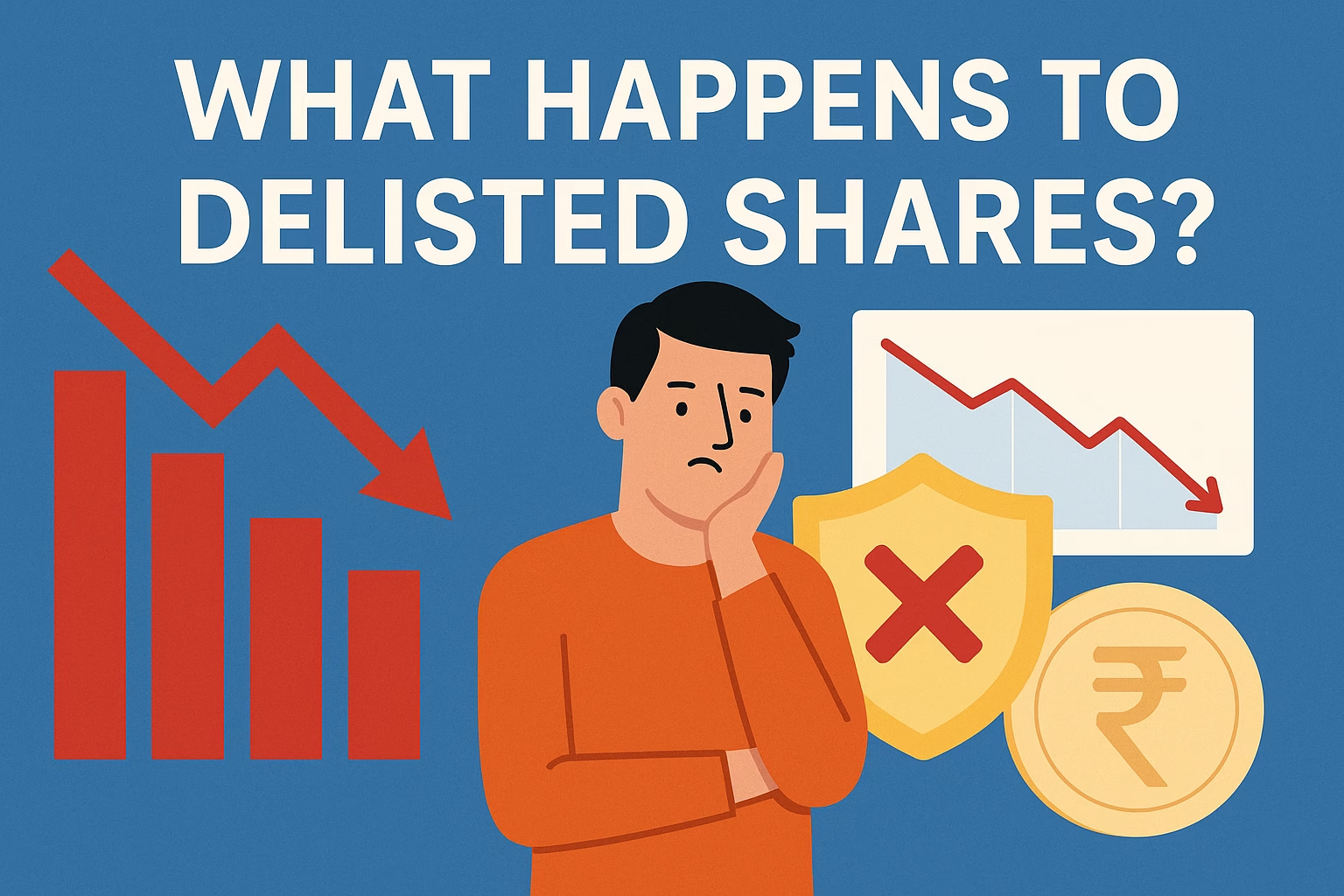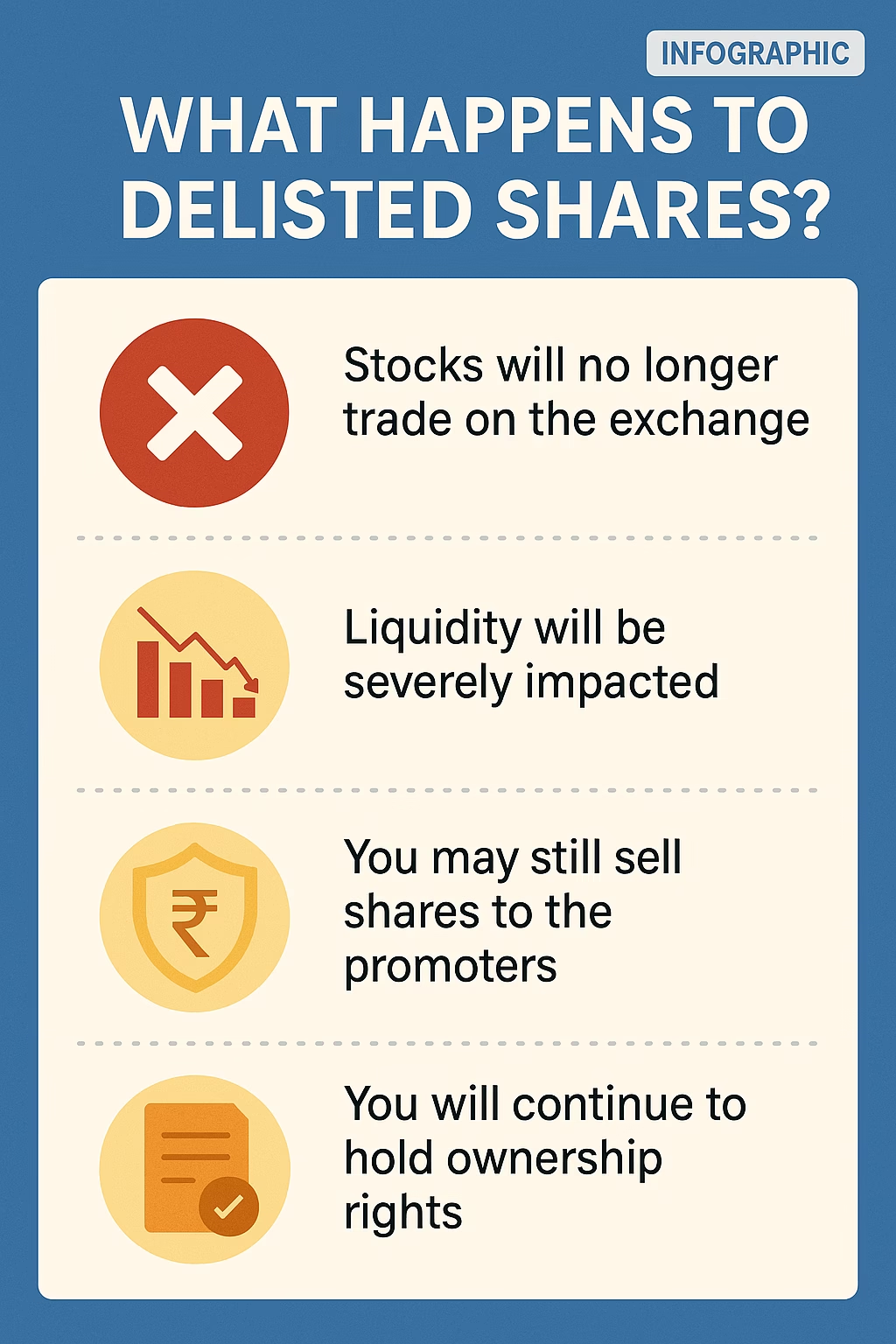📉 Introduction: What Are Delisted Shares?
Imagine discovering a stock you used to trade is no longer included in your portfolio when you open it. No buyers, no price changes. The exchange no longer has it. Now what? One of the most perplexing circumstances a retail investor may encounter is delisted shares, which is reflected in this scenario. Delisting causes uncertainty, fear, and frequently losses, regardless of whether the company made the decision voluntarily or as a result of a forced regulatory action. The fact is, however, that delisting isn’t always the end. This comprehensive guide will explain what delisted shares are, why they are delisted, how they impact your investments, your legal rights, and what to do if you ever find yourself in this predicament.

❌ What Are Delisted Shares?
A company’s stock that has been taken off of a stock exchange, such as the NSE or BSE, is referred to as a delisted share. Shares of the company are no longer traded by the general public on the secondary market after they are delisted.
Two main categories of delisting exist:
1. Delisting voluntarily
When a business voluntarily withdraws its shares from the exchange, this occurs. Typical explanations include:
- Mergers or acquisitions
- Taking a private route
- Strategic restructuring
- The parent company is combining its worldwide operations.
In this situation, the business typically notifies current shareholders of an exit opportunity.
2.Compulsory Delisting
This happens when the company is forced to delist by a stock exchange or SEBI because of:
- Continuous non-compliance with regulations
- Failure to file financial results
- Fraud or suspicious activity
- extended suspension of trading
Investors typically have a harder time getting their money back in this situation.
🤔 What Happens to Delisted Shares?
The type of delisting determines what happens to shares that are delisted. Let’s dissect it
Voluntary Delisting:
✅ Buyback Offer: The business must make a reverse book building offer to repurchase shares from public shareholders at a determined price.
✅ Option to Hold: You may keep the shares in your demat account if you choose not to accept the offer. You still own a portion of the business.
✅ Off-market Sales: Although liquidity will be limited, you may sell your delisted shares to institutional buyers or through off-market transactions.
✅ Dividends and Rights: Depending on your holdings, you may be eligible for dividends or rights issues.
Compulsory Delisting:
❌ No Exit Opportunity: Official buybacks and exit prices are frequently absent.
❌ Loss of Liquidity: It becomes more difficult to sell your delisted shares because they are less liquid..
❌ Value Loss: The shares typically experience a significant, occasionally total, decline in value.
❌ Legal Recourse: Investors may file an appeal with SEBI, but unless malpractice is demonstrated, results are rarely positive.

📜 SEBI Rules Regarding Delisted Stocks
The SEBI (Delisting of Equity Shares) Regulations provide explicit guidelines for voluntary delisting.
- To delist, the acquirer and individuals working together must own at least 90% of the shares.
- The exit price is calculated using reverse book building.
- The offer is up to the shareholders to accept or reject.
Regarding mandatory delisting:
- After providing sufficient notice, exchanges are permitted to delist companies.
- Promoters may be prohibited from reentering the market, and companies are placed on a blacklist.
- Investors with delisted shares are required to look for legal alternatives or direct transactions.
Although these regulations are intended to safeguard investor rights, their implementation is constrained.
🏦 How Can Delisted Shares Be Sold?
You are unable to sell a stock on the stock exchange after it has been delisted. But these are your choices:
1. Off-Market Transfers:
You can send shares straight to a buyer by using your depository participant (NSDL/CDSL).
2. Company Buyback:
If you choose to delist voluntarily, the company may still purchase your shares.
3. Unlisted Markets or Grey Market:
Platforms and brokers that focus on buying and selling shares that are delisted or unlisted exist. Before using them, do extensive research.
4. Wait for Relisting (Rare):
Some businesses may fix problems and relist, giving investors another opportunity.
📈 Real-World Examples
🟢 Vedanta Limited (2020)
tried delisting voluntarily. The offer made to investors was ₹87.5 per share. The strategy didn’t work out, though, and the business remained listed. Gains were later realized by those who owned shares.
🔴 Kingfisher Airlines
was forced to delist following a financial meltdown. Investors who held delisted shares faced a 100% loss and had no way to sell.
These instances demonstrate how unique each delisting is and how important research is.
Smallcap Stocks Under ₹100 with Strong Fundamentals for 2025
⚠️ Risks of Holding Delisted Shares
- Illiquidity: No active buyers
- Price Uncertainty: No market-driven pricing mechanism
- Fraud Risk: High in cases of forced delisting
- Limited Information: Companies stop making public disclosures
- Capital Loss: Complete erosion of investment possible
Not all delisted shares are worthless, despite the dangers. Some businesses stay in business and might even relist or pay dividends in the future.
🔐 Legal Rights and Investor Action
Even if a company is delisted, you retain these rights:
- Ownership: You are still a legal shareholder
- Communication: You can demand company updates
- Dividends: If declared, you are entitled to receive them
- Right to Sue: You can pursue legal action in consumer or company courts
Organizations like SEBI, SCORES (SEBI Complaint Redress System), and investor protection groups can help if you feel cheated.
🔍 How to Avoid Getting Stuck with Delisted Shares
- Track Announcements: Monitor stock exchange notices and corporate disclosures
- Avoid Suspended Stocks: Never invest in stocks that haven’t traded in months
- Check Compliance Track Record: Regular filings and AGMs are signs of good governance
- Diversify: Never put more than 5% of your portfolio in a single small or risky stock
- Use Stop-Loss: Exit early if red flags appear
Preventive investing is the best way to avoid the stress of holding delisted shares.
📊 Comparison: Voluntary vs Compulsory Delisting
| Factor | Voluntary Delisting | Compulsory Delisting |
|---|---|---|
| Exit Option | Yes (buyback offer) | Rarely or never |
| Cause | Strategy, merger, private | Fraud, non-compliance |
| Investor Rights | Protected by SEBI | Limited after delisting |
| Value Retention | Moderate to High | Low to Zero |
| Liquidity After Delisting | Limited but possible | Almost zero |
🧠 Final Thoughts: Don’t Panic, Get Informed
Don’t freak out if your shares are delisted. Learn the rationale for the delisting first. Next, look into your market and legal options. Additionally, keep in mind that not all delisted businesses are frauds; some are calculated actions that could be profitable.
Retail investors need to be vigilant, knowledgeable, and diversified as the Indian capital market changes.
Knowing what happens to shares that are delisted gives you power and safeguards your investment.
📣 Call to Action
💬 Ever faced a delisting situation? Share your experience below.
📤 Know someone holding delisted shares? Send them this article.
🛡️ Want help reviewing your stock portfolio for delisting risks? Ask away!
